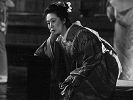Eye For Film >> Movies >> Life Of Oharu (1952) Film Review

One of the greatest challenges faced by the disadvantaged in any society is the difficulty of communicating to those in power the reality of their situation. As a meditation on the traditional position of women in Japanese society, Life Of Oharu uses the authority of distance and the rituals of art to tell a story whose relevance extends far beyond its setting and subject, providing comment on a society undergoing massive changes at the time it was made, and maintaining its importance today.
Oharu (Kinuyo Tanaka, in her 14th collaboration with director Kenji Mizoguchi) is a woman whose life is defined by others' reaction to her appearance. When we first meet her, she is hiding her face. She is 50 years old, and her appearance - her reliance on the concealment of cosmetics - is used by an old man to preach to the young about the foolishness of hiring such a woman, and about the consequences of sin. Like most such judges, he cannot know her story, and he does not seem to grasp the secondary function of those cosmetics as a concocted display of sexual interest, ritual trappings enabling her to pursue her occupation without being betrayed by her real feelings. Throughout the film, as we look backwards to see what has brought her to this, she is presented in elaborate costumes signalling various kinds of status, functioning as various kinds of disguise. Through these many roles, the art of performance emerges as paramount. If Oharu is anything, she is an actress - but she is straining to reveal her honest self.

Her story begins in her youth, in a formal kimono with a stiff bow at the back so that she walks bent over, teetering on wooden clogs. This is the life of a noblewoman, and the restriction it implies is extensive. When she falls in love with a man beneath her station (Toshiro Mifune, even then a kind of cinematic royalty) her family is engulfed in scandal, and she begins the slide into a series of increasingly unfortunate situations, with her aggrieved father ready to sell her (a not uncommon practice in the late 1800s) in order to recover his fortunes. Her very reticence makes her desirable as a lover or a servant, and attempts to improve her own circumstances as inherently unfeminine, which is assumed to make her culpable in her misfortune. Though this episodic tale is based loosely on Ihara Saikaku's The Life Of An Amorous Woman, it incorporates none of the author's leavening wit. Instead Mizoguchi tells it straight, using his artistry to seduce the audience with beautiful images and intriguing historical details which hold it captive as the true horror of events becomes apparent.
In the leading role, Tanaka is extraordinary, depicting not only a woman who must navigate through socially complex and tremendously stressful situations, but illustrating the changes she goes through over 30 years, giving us glimpses of the person inside the costumes. Her work is more challenging because Mizoguchi deliberately keeps her at one remove; we are near her, often above, never with, never walking in her shoes. Yet she is the only constant in the film, and we the only witnesses to her efforts to live a virtuous life. Daringly, Mizoguchi parallels Oharu's story with the classic tale of the penitent who achieves salvation by way of suffering itself, in defiance of the traditional exclusion of women (and especially sexual women) from this narrative path. It's a stance that elevates not just his heroine but women in general, and that slyly critiques the modern capitalist values then encroaching on Japan from the West - even though he clearly recognises the way post-war Western influence has advanced women's rights, nd it is traditional Japanese ideas that come in for the strongest criticism.
What really elevates Mizoguchi's work above other films of this type - and even modern variants like I, Daniel Blake - is his abstraction of the problem, looking beyond individuals at a set of behaviours and ideals that have no clear progenitor. The men in the story are not monstered, even when they behave monstrously - it simply doesn't occur to them that Oharu is a person in the same way as they are. And through this focus on the treatment of women, Mizoguchi also comments on class, revealing the constraints that bind each character in place within a centuries old hierarchy. At a time when cinema still limited emotional displays by men, Tanaka communicates on their behalf.
Of all Mizoguchi's works, this was one of the ones he was most pleased by. It spoke to his deep longing to understand and express what it could mean to live as women did, and also to his fascination with history. This latter interest reveals itself in superbly accurate set and costume design, and also in his use of iconic imagery that owes much to traditions in Japanese paining and was important in bringing thee traditions to bear on the rapidly developing medium of cinema. An ancestor to masterpieces like When A Woman Ascends The Stairs, this film also influenced popular entertainment and the ways in which the modernising nation connected with and depicted its past. Today, still less than a century from the end of feudalism, Japan and Japanese cinema might seem to have changed immeasurably, yet we still might glimpse Oharu in a Pale Moon or Confessions, whenever a woman hides her face.
Reviewed on: 22 Apr 2017
















